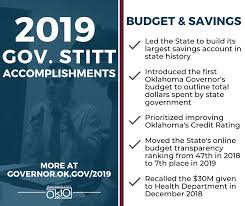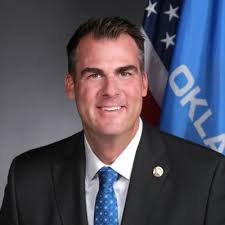
Oklahoma Gov. Kevin Stitt has released a report of his administration’s first-year accomplishments in attempting to make Oklahoma a Top Ten state.
“You elected me with a mandate to put a fresh set of eyes on state government, to put an end to short-term, status quo decision making, and to deliver strong accountability and transparency,” said the governor in announcing the report. “I can confidently say that with your help we have achieved a year of historic firsts, all of which you will find in the inaugural edition of the Stitt administration’s annual accomplishments report by clicking here.”
Among the different areas of accomplishment, the governor cited progress in the Oklahoma Energy and Environment Agency. Here is what he cited in the agency:
Collaborated efforts to launch the Oklahoma Fishing Trail
• Oklahoma Department of Wildlife Conservation has been working in partnership with the Oklahoma Tourism and Recreation Department to launch the Oklahoma Fishing Trail. This vision by Lt. Gov. Pinnell is showcasing the state’s booming fishing industry, reinforced by the $1.8 billion spent by anglers annually and supporting more than 15,000 jobs throughout the state.

• The Department of Environmental Quality entered into a multi-agency partnership to help small public water supply systems with voluntary water loss audits. This partnership has helped to complete 175 water loss audits and has helped to reveal 6.9 billion gallons in real loss due to leaks. Issues corrected, so far, that were identified by the audits and leak detection total 490.4 million gallons per year of fixed real loss, valued at $1.2 million per year.
• The Department of Environmental Quality continued to make additional gains in energy efficiencies. DEQ has retrofitted and removed older lights, replaced light fixtures and taken on mechanical projects to increase energy savings. Since 2012, DEQ has reduced electric kilowatt-hour usage by 40% and natural gas
DTH usage by 53% inside its agency building.
• The Oklahoma Water Resources Board approved financing for 50 Oklahoma communities totaling over $353 million for an estimated savings of $31.7 million over traditional financing.
• In 2019, Oklahoma Municipal Power Authority’s Demand and Energy Efficiency Program provided rebates to 62 of our members’ commercial and industrial customers for energy efficiency improvements. The total amount rebated was $317,564.47, which results in a 2.1 mW reduction for OMPA. Among those 62 rebates, 10 were given to public schools for a total of $72,425, resulting in an 827 kW reduction.
• In 2019, ODWC entered into a new process for liquidating surplus vehicles and equipment, resulting in a drastic improvement on staff time spent on the process and an average 30% increase in price of vehicles sold. The materials are sold at no cost to ODWC.
• Oklahoma Department of Mines has relocated the Wagoner field office to Tulsa. This moves the permitting and inspection functions to a more centralized location for citizens in the second highest production zone in the state. Additionally, online trainings can be held in the Tulsa office conference room, which is equipped
with multimedia equipment, to reduce overall travel costs for the industry seeking their mandatory training requirements.
Digitized the Oklahoma Water Resources Board
• Nearly 100% of OWRB documents were digitized and stored electronically, improving staff productivity and minimizing equipment and office space requirements.
• OWRB held free and low-cost online training opportunities that saved money on travel expenses. Online webinars were held on specific programs, saving additional travel costs as well as space rental fees.
• The LP Gas administration is implementing a digital online application for the benefit of the approximately 9,000 permit holders to apply for and renew their LP gas permits annually.
The Oklahoma Corporation Commission has implemented an audio/visual equipment expansion that has reduced costs for travel, personnel time and increased accessibility for court proceedings and trainings, valued at $887,000 savings.
• The ODWC has rolled out the Go Outdoors Oklahoma license management system to make it more easily accessible for hunters and anglers to acquire licenses.
Updated online servers
• OCC replaced Intents to Drill servers, which reduced system outages by 100% by moving to the Microsoft standard server.
• OCC implemented ITD processing improvements, reducing backlog by 20%, and increased monthly ITD approval by 32%.
• OCC implemented the risk-based data management systems desktop upgrade. This system allows operators to file e-forms based on all their wells, as opposed to filing forms for individual wells, which decreases operator entry time significantly.
• The Department of Environmental Quality provided free assistance to private water well owners impacted by flooding with 525 technical assistance contacts, 331 sample kits provided and 147 tests conducted.
• In April 2019, the Grand River Dam Authority was again one of 208 out of approximately 2,000 public power utilities designated by the American Public Power Association as a Platinum Level Reliable Public Power Provider. The RP3 award is for utilities.
• The OWRB Dam Safety program held free technical workshops, along with free inspections of low-hazard dams and finalization of Emergency Action Plans for over 95% of Oklahoma’s 370 high-hazard dams.
• Environmental agencies are working to improve permitting times by 30% and workgroups are making significant progress to achieve that goal.
• The Oklahoma Geological Survey has achieved their FY 2019 goal of establishing a comprehensive seismic network for earthquake detection and geophysical research and ensuring that they are 90% operational.
Source: Governor’s report



